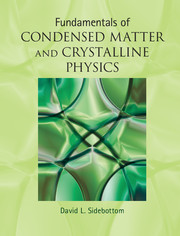 Fundamentals of Condensed Matter and Crystalline Physics
Fundamentals of Condensed Matter and Crystalline Physics from Part IV - Transitions
Published online by Cambridge University Press: 05 August 2012
Introduction
Our discussion of critical phenomena surrounding a second-order phase transition has thus far focused only on qualitative features. We have now examined three systems, fluids, magnets and random percolation, each of which displays an abruptly sharp transition from a less ordered to a more ordered phase as the respective transition point is encountered. Each shows a similar pattern of developing structure just in advance of the critical point. Fluctuations in the respective order parameter display a self-similar structure that is limited only by a single relevant length scale, the correlation length ξ, which diverges on approach to the transition point. For fluids and magnets, this structure arises from inherent fluctuations that are amplified by either a diverging compressibility or susceptibility, respectively.
In this chapter, we explore more quantitative, theoretical approaches taken to understand the features of second-order phase transitions. The simplest of these are the mean field theories, in which the pairwise interaction (needed to produce a phase transition) is introduced in the form of an average field. In this approach, the effects of the growing fluctuations of the order parameter near the critical point are ignored. Although the mean field approach does meet many of the requirements and does predict divergences of certain quantities near the transition, the critical exponents predicted by the theory do not match those seen experimentally. Obtaining correct exponents requires a more advanced approach involving renormalization techniques that exploit the self-similar structure of the fluctuations near the critical point and allow all of the various critical exponents to be inter-related, such that knowledge of any two yields all the others.
To save this book to your Kindle, first ensure [email protected] is added to your Approved Personal Document E-mail List under your Personal Document Settings on the Manage Your Content and Devices page of your Amazon account. Then enter the ‘name’ part of your Kindle email address below. Find out more about saving to your Kindle.
Note you can select to save to either the @free.kindle.com or @kindle.com variations. ‘@free.kindle.com’ emails are free but can only be saved to your device when it is connected to wi-fi. ‘@kindle.com’ emails can be delivered even when you are not connected to wi-fi, but note that service fees apply.
Find out more about the Kindle Personal Document Service.
To save content items to your account, please confirm that you agree to abide by our usage policies. If this is the first time you use this feature, you will be asked to authorise Cambridge Core to connect with your account. Find out more about saving content to Dropbox.
To save content items to your account, please confirm that you agree to abide by our usage policies. If this is the first time you use this feature, you will be asked to authorise Cambridge Core to connect with your account. Find out more about saving content to Google Drive.